
Indian locomotives
Encyclopedia

Locomotive
A locomotive is a railway vehicle that provides the motive power for a train. The word originates from the Latin loco – "from a place", ablative of locus, "place" + Medieval Latin motivus, "causing motion", and is a shortened form of the term locomotive engine, first used in the early 19th...
s in India
India
India , officially the Republic of India , is a country in South Asia. It is the seventh-largest country by geographical area, the second-most populous country with over 1.2 billion people, and the most populous democracy in the world...
consist of electric
Electric locomotive
An electric locomotive is a locomotive powered by electricity from overhead lines, a third rail or an on-board energy storage device...
and diesel locomotive
Diesel locomotive
A diesel locomotive is a type of railroad locomotive in which the prime mover is a diesel engine, a reciprocating engine operating on the Diesel cycle as invented by Dr. Rudolf Diesel...
s. Steam locomotive
Steam locomotive
A steam locomotive is a railway locomotive that produces its power through a steam engine. These locomotives are fueled by burning some combustible material, usually coal, wood or oil, to produce steam in a boiler, which drives the steam engine...
s are no longer used, except in heritage trains
Restored trains
Restored trains are historic trains that have been removed from service and later restored to their past condition, as opposed to having never been removed from service, like UP 844, the only U.S. steam locomotive to never be retired. They are operated in present day service as moving examples of...
. Locomotives are also called locos or engines.
The Bengal Sappers of the Indian Army
Indian Army
The Indian Army is the land based branch and the largest component of the Indian Armed Forces. With about 1,100,000 soldiers in active service and about 1,150,000 reserve troops, the Indian Army is the world's largest standing volunteer army...
were the first to run a steam locomotive in India. The steam locomotive named ‘Thomason’ ran with two wagons for carrying earth from Roorkee
Roorkee
Roorkee is a city and seat of a municipal council in Uttarakhand, in far northern India. It is located on the banks of the Ganges canal on the national highway between Delhi and Dehradun. Roorkee is known for Roorkee Cantonment, one of the country's oldest cantonments, and the headquarters of...
to Piran Kaliyar in 1851, two years before the first passenger train ran from Bombay to Thane
Thane
Thane , is a city in Maharashtra, India, part of the Mumbai Metropolitan Region, northeastern suburb of Mumbai at the head of the Thane Creek. It is the administrative headquarters of Thane district. On 16 April 1853, G.I.P...
in 1853. The steam engine is presently exhibited at Roorkee Railway Station.
Classification of Locomotives
In IndiaIndia
India , officially the Republic of India , is a country in South Asia. It is the seventh-largest country by geographical area, the second-most populous country with over 1.2 billion people, and the most populous democracy in the world...
, locomotive
Locomotive
A locomotive is a railway vehicle that provides the motive power for a train. The word originates from the Latin loco – "from a place", ablative of locus, "place" + Medieval Latin motivus, "causing motion", and is a shortened form of the term locomotive engine, first used in the early 19th...
s are classified according to their track gauge, motive power, the work they are suited for and their power or model number. The class name includes this information about the locomotive. It comprises 4 or 5 letters. The first letter denotes the track gauge. The second letter denotes their motive power (Diesel or Electric) and the third letter denotes the kind of traffic for which they are suited (goods, passenger, mixed or shunting).
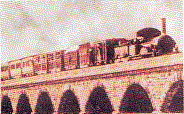
Horsepower
Horsepower is the name of several units of measurement of power. The most common definitions equal between 735.5 and 750 watts.Horsepower was originally defined to compare the output of steam engines with the power of draft horses in continuous operation. The unit was widely adopted to measure the...
range. Electric locomotives don't come under this scheme and even all diesel locos are not covered. For them this letter denotes their model number as usual.
A locomotive may sometimes have a fifth letter in its name which generally denotes a technical variant or subclass or subtype. This fifth letter indicates some smaller variation in the basic model or series, perhaps different motors, or a different manufacturer. With the new scheme for classifying diesel locomotives (as mentioned above) the fifth item is a letter that further refines the horsepower indication in 100 hp increments: 'A' for 100 hp, 'B' for 200 hp, 'C' for 300 hp, etc. So in this scheme, a WDM-3A refers to a 3100 hp loco, while a WDM-3F would be a 3600 hp loco.
Note: This classification system does not apply to steam locomotives in India
India
India , officially the Republic of India , is a country in South Asia. It is the seventh-largest country by geographical area, the second-most populous country with over 1.2 billion people, and the most populous democracy in the world...
as they have become non-functional now. They retained their original class names such as M class or WP class
Indian locomotive class WP
Indian locomotive class WP is a class of 4-6-2 "Pacific" steam locomotives used in India. The class was introduced after World War II for passenger duties, marking the change from 'X' to 'W' for broad gauge locomotives. It was capable of doing up to and was easily recognized by the cone-shaped...
.
The classification syntaxes
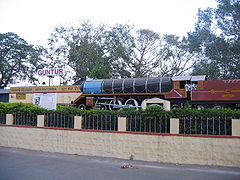
- W-Indian broad gauge (The "W" Stands for Wide Gauge - 5 Feet)
- Y-metre gaugeMetre gaugeMetre gauge refers to narrow gauge railways and tramways with a track gauge of . In some African, American and Asian countries it is the main gauge. In Europe it has been used for local railways in France, Germany, and Belgium, most of which were closed down in mid 20th century. Only in Switzerland...
(The "Y" stands for Yard Gauge - 3 Feet) - Z-narrow gauge(2 ft 6 in)
- N-narrow gauge (2 ft)
The second letter (motive power)
- D-DieselDiesel engineA diesel engine is an internal combustion engine that uses the heat of compression to initiate ignition to burn the fuel, which is injected into the combustion chamber...
- C-DC electric (can run under DC traction only)
- A-AC electric (can run under AC traction only)
- CA-Both DC and AC (can run under both AC and DC tractions), 'CA' is considered a single letter
- B-Battery electric locomotive (rare)
The third letter (job type)
- G-goods
- P-passenger
- M-mixed; both goods and passenger
- S-Used for shunting (Also known as switching engines or switchers in United statesUnited StatesThe United States of America is a federal constitutional republic comprising fifty states and a federal district...
and some other countries) - U-Electric multiple units (used as commuters in city suburbs)
- R-Railcars
For example, in "WDM 3A":
- "W" means broad gaugeBroad gaugeBroad-gauge railways use a track gauge greater than the standard gauge of .- List :For list see: List of broad gauges, by gauge and country- History :...
- "D" means dieselDiesel engineA diesel engine is an internal combustion engine that uses the heat of compression to initiate ignition to burn the fuel, which is injected into the combustion chamber...
motive power - "M" means suitable for mixed(for both goods and passenger)service
- "3A" means the locomotive's power is 3,100 hp ('3' stands for 3000 hp, 'A' denotes 100 hp more)
Or, in "WAP 5":
- "W" means broad gauge
- "A" mean AC electric traction motive power
- "P" means suitable for Passenger service
- "5" denotes that this locomotive is chronologically the fifth electric locomotive model used by the railways for passenger service.
Steam traction
- WP classIndian locomotive class WPIndian locomotive class WP is a class of 4-6-2 "Pacific" steam locomotives used in India. The class was introduced after World War II for passenger duties, marking the change from 'X' to 'W' for broad gauge locomotives. It was capable of doing up to and was easily recognized by the cone-shaped...
4-6-2 – 3 preserved officially (no's 7015, 7161 and 7200), while 4 others also exist in good condition. One is rusting away in the open at Tinsukhia, Assam, and is in an extremely pitiful state.
Diesel traction
- WDM - Wide Diesel Mixed
- WDP - Wide Diesel Passenger
- WDG - Wide Diesel Goods
- WDS - Wide Diesel Shunter
----
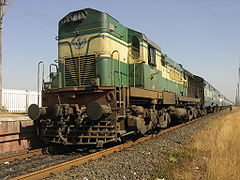
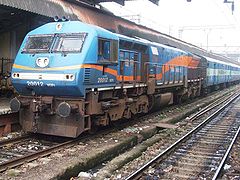

- WDM 1 (First mainline diesel electric locomotives used in IndiaIndiaIndia , officially the Republic of India , is a country in South Asia. It is the seventh-largest country by geographical area, the second-most populous country with over 1.2 billion people, and the most populous democracy in the world...
. Introduced in 1957. Imported from ALCO. Out of service now. 1950 hp) - WDM 2 (Most widely used and first homemade mainline diesel-electric locomotives in India. Original prototypes were made by ALCO. Introduced in 1962. More than 2700 have been made. Rated at 2600 hp)
- WDM 2A,WDM 2B (Technical variants of WDM 2)
- WDM 3 (Only 8 were imported. They used hydraulic transmission and are currently non-functional)
- WDM 3A (Formerly WDM 2C. Another WDM 2 variant. It is not related to WDM 3. 3100 hp)
- WDM 3A R (Formerly WDM 2. It is a rebuilt with DBR fitted on Short Hood. It is not related to WDM 3. 3100 hp)
- WDM 3C, WDM 3D (higher powered versions of WDM 3A)
- WDM 4 (Entered service along with WDM 2. Prototypes designed by General Motors. Though considered superior to WDM 2 in many ways, these locomotives weren't chosen as General Motors did not agree to a technology transfer agreement. 2600 hp)
- WDM 6 (Very rare class; only two were made; one is being used by PuttalamPuttalamPuttalam is the capital city of the Puttalam District in North Western Province, Sri Lanka.-History:The history of this dry zone dates back to the arrival of Prince Vijaya, nearly 2500 years ago, when his vessel washed ashore. The name "Puttalam" may be a modification of the Tamil word Uppuththalam...
Cement Factory in Sri LankaSri LankaSri Lanka, officially the Democratic Socialist Republic of Sri Lanka is a country off the southern coast of the Indian subcontinent. Known until 1972 as Ceylon , Sri Lanka is an island surrounded by the Indian Ocean, the Gulf of Mannar and the Palk Strait, and lies in the vicinity of India and the...
. Rated at 1200 HP) - WDM 7 (Fifteen of these locos were built from June 1987 through 1989, they were designed for branch-line duties, but they are now used mostly for shunting. Rated at 2000hp)
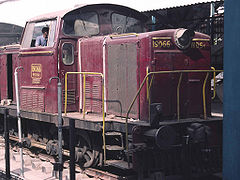
Note: No locomotive class was designated as WDM 5 in India.
Passenger locomotives:
- WDP 1
- WDP 2 (New class name WDP 3A. Dedicated passenger diesel locomotive. Entered service in 1998. Powerful locomotive. 3100 hp)
- WDP 3 (This locomotives are actually prototypes of the class WDP 1 and never entered serial production.)
- WDP 4 (EMD (former GM-EMD) GT46PACEMD GT46PACThe EMD GT46PAC is a passenger-hauling diesel-electric locomotive with AC electric transmission designed by General Motors Electro-Motive Division and built by both GM-EMD and under license by Diesel Locomotive Works of Varanasi, India for Indian Railways as their classes WDP-4, WDP-4B and WDP-4D...
, fundamentally a passenger version of the WDG 4 (GT46MACEMD GT46MACThe EMD GT46MAC is a freight-hauling diesel-electric locomotive with AC electric transmission built by General Motors Electro-Motive Divisionin 1997–1998 for Indian Railways, where they are classed as WDG-4....
). 4000 hp) - WDP 4B (EMD (former GM-EMD) GT46PACEMD GT46PACThe EMD GT46PAC is a passenger-hauling diesel-electric locomotive with AC electric transmission designed by General Motors Electro-Motive Division and built by both GM-EMD and under license by Diesel Locomotive Works of Varanasi, India for Indian Railways as their classes WDP-4, WDP-4B and WDP-4D...
, An improved version of the WDP 4, this is a more powerful version and has 6 traction motors, just like the WDG 4. Also comes with wider cabin to aid visibility and minor exterior design changes. 4500 hp) - WDP 4D (EMD (former GM-EMD) GT46PACEMD GT46PACThe EMD GT46PAC is a passenger-hauling diesel-electric locomotive with AC electric transmission designed by General Motors Electro-Motive Division and built by both GM-EMD and under license by Diesel Locomotive Works of Varanasi, India for Indian Railways as their classes WDP-4, WDP-4B and WDP-4D...
, This is basically a WDP 4B with twin cabs. Minor changes were made to the locomotive to facilitate the addition of a second cabin. This locomotive comes with LCD instrument display and toilet for the drivers. As of now, two units have been made and are expected to enter full-time service soon. 4500 hp)
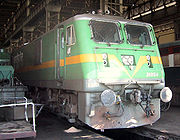
- WDG 2 (New class name WDG 3A. These class is actually a technically upgraded form of WDM 2)
- WDG 3B, WDG 3C, WDG 3D (Technical upgraded forms of WDG 2 or WDG 3A)
- WDG 4 (New dedicated goods locomotives. These are General motors' GT46MACEMD GT46MACThe EMD GT46MAC is a freight-hauling diesel-electric locomotive with AC electric transmission built by General Motors Electro-Motive Divisionin 1997–1998 for Indian Railways, where they are classed as WDG-4....
models. First units were imported in 1999. They are numbered from #12000 upward. Local production started on 2002. 4000 hp)
Shunting locomotives (Also known as switching engines):
- WDS 1 (First widely deployed and successful diesel locomotives used in India. Imported in 1944-45. currently out of service. 386 hp)
- WDS 2 (currently out of service.)
- WDS 3 (All locomotives of this class were rebuilt and reclassified as WDS 4C in 1976-78. 618 hp)
- WDS 4,WDS 4A,WDS 4B,WDS 4D (Designed by Chittaranjan Locomotive Works. 600-700 hp)
- WDS 4C (Rebuilt WDS 3 locos as mentioned above)
- WDS 5 (Some of these locomotives are used for industrial shunting. A few are used on Indian Railways. Rated at 1065hp)
- WDS 6 (Heavy-haul shunters made in large numbers for industrial concerns as well as for Indian Railways Rated at 1200/1350hp)
- WDS 8 (Only five of these were made, and all were transferred to steel works 800hp)
Note: There is no electric shunting engine in India. Classes from WDS 1 to WDS 4D have hydraulic transmission. The WDS 4, 4A, 4B, 4C and 4D are the only still existing broad gauge locomotives with diesel-hydraulic transmission.
Diesel multiple units:
A few routes in India currently have Diesel multiple unit service. Depending on the transmission system they are classified as DEMU (diesel-electric transmission) or DHMU (diesel-hydraulic transmission). There are diesel railcar service in a few places known as 'railbus'.
DC electric traction
----Note: These locomotives are, or were used only in sections around Mumbai
Mumbai
Mumbai , formerly known as Bombay in English, is the capital of the Indian state of Maharashtra. It is the most populous city in India, and the fourth most populous city in the world, with a total metropolitan area population of approximately 20.5 million...
which is the only location in India still using DC traction.The power operated is 1500V DC.
Mixed type locomotives:
- WCM 1 ( First electric locomotives with the now familiar Co-Co wheel arrangement to be used in India. 3700 hp)
- WCM 2 (520hp)
- WCM 3 (600hp - Used in Kolkata , then transferred to Mumbai, Built by Hitachi)
- WCM 4 (675hp - Also built by Hitachi)
- WCM 5 (Built by Chittaranjan locomotive works to RDSO's design specifications. Auxiliaries by Westinghouse and North Boyce. Built in 1962, these are India's first indigenously designed DC electric locomotives. The first was named 'Lokamanya' after the CongressIndian National CongressThe Indian National Congress is one of the two major political parties in India, the other being the Bharatiya Janata Party. It is the largest and one of the oldest democratic political parties in the world. The party's modern liberal platform is largely considered center-left in the Indian...
leader Bal Gangadhar TilakBal Gangadhar TilakLokmanya Tilak –, was an Indian nationalist, teacher, social reformer and independence fighter who was the first popular leader of the Indian Independence Movement. The British colonial authorities derogatorily called the great leader "Father of the Indian unrest"...
. 3700 hp) - WCM 6 (A rare and highly powerful class. 5000 hp,only two were built. Now converted to run on AC power, class name changed to WAM 4)
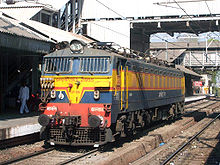
- WCP 1,WCP 2 (GIPRGreat Indian Peninsular RailwayThe Great Indian Peninsula Railway was a predecessor of the Indian Central Railway, whose headquarters was at the Boree Bunder in Bombay . The Great Indian Peninsula Railway was incorporated on August 1, 1849 by an act of the British Parliament. It had a share capital of 50,000 pounds...
EA/1 and EA/2. Historically very important locomotives as these are the very first electric loco to be used in India. The first locomotive was named as Sir Roger Lumney and is currently preserved in the National Rail MuseumNational Rail Museum, New DelhiThe National Rail Museum is a museum in Chanakyapuri, New Delhi which focuses on the rail heritage of India it opened on the 1 February, 1977. It is located in over of land with both indoor and outdoor exhibits. A toy train offers rides around its site on regular days...
, New Delhi. 2160 hp) - WCP 3,WCP 4 (GIPR EB/1 and EC/1, these are also among the earliest electric locos used in India)
Goods locomotives:
- WCG 1 (GIPR EF/1. These are Swiss crocodileCrocodile (locomotive)Crocodile electric locomotives are so called because they have long "noses" at each end, reminiscent of the snout of a crocodile . These contain the motors and drive axles, and are connected by an articulated center section. The center section usually contains the crew compartments, pantographs...
locomotives imported in 1928 from SwissSwitzerlandSwitzerland name of one of the Swiss cantons. ; ; ; or ), in its full name the Swiss Confederation , is a federal republic consisting of 26 cantons, with Bern as the seat of the federal authorities. The country is situated in Western Europe,Or Central Europe depending on the definition....
locomotive works. These are among the earliest electric locos used in India.The first locomotive was named as Sir Leslie Wilson and is currently preserved in the National Rail MuseumNational Rail Museum, New DelhiThe National Rail Museum is a museum in Chanakyapuri, New Delhi which focuses on the rail heritage of India it opened on the 1 February, 1977. It is located in over of land with both indoor and outdoor exhibits. A toy train offers rides around its site on regular days...
, New Delhi. 2600-2950 hp)) - WCG 2 (Designed by Chittaranjan locomotive works in 1970.)
Electric multiple units:
- WCU 1 to WCU 15 (Used in Mumbai region only)
AC electric traction

Mixed type locomotives
- WAM 1 (Among the first AC electric locomotives used in India. Introduced in 1959. Now out of service. 3010 hp)
- WAM 2
- WAM 3
- WAM 4Indian locomotive class WAM-4WAM-4 is the name of a type of electric locomotive used in India. It is a very successful locomotive in Indian Railways' fleet. The first one was indigenously designed and built by CLW in 1970-71. They were produced until about 1997. They use the same power bogies as the successful WDM-2 class....
(Indigenously designed by Chittaranjan Locomotive Works in 1970. Highly powerful class. One of the most successful locomotives in India. 3850 hp)
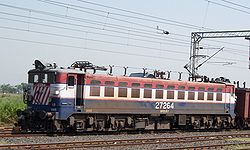
Passenger locomotives
- WAP 1 (Designed by Chittaranjan locomotive works in 1980 for the KolkataKolkataKolkata , formerly known as Calcutta, is the capital of the Indian state of West Bengal. Located on the east bank of the Hooghly River, it was the commercial capital of East India...
-DelhiDelhiDelhi , officially National Capital Territory of Delhi , is the largest metropolis by area and the second-largest by population in India, next to Mumbai. It is the eighth largest metropolis in the world by population with 16,753,265 inhabitants in the Territory at the 2011 Census...
Rajdhani ExpressRajdhani ExpressRajdhani Express is a passenger train service in India connecting New Delhi with other important destinations, especially state capitals. Rajdhani means "The Capital" in Hindi.- History :...
. A very successful class. 3900 hp) - WAP 2 (Not in use)
- WAP 3 (Not in use)
- WAP 4Indian locomotive class WAP-4WAP-4 is one of the most important electric locomotives used in India. It is a very powerful class capable of hauling 26 coaches at a speed of 140 km/h...
(Upgraded from WAP 1 for higher loads by Chittaranjan locomotive works in 1994. One of the most successful locomotives in India. Very powerful class. 5350 hp) - WAP 5 (Imported in 1995 from Switzerland and used on premier express trains. 5450 hp)
- WAP 6 Only found near Asansol
- WAP 7 (Same design as WAG 9 with modified gear ratio. Highly powerful class. 6250 hp)
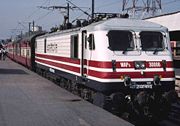
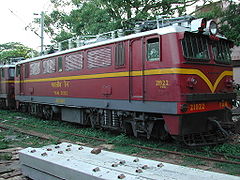
Goods locomotives
- WAG 1
- WAG 2
- WAG 3
- WAG 4
- WAG 5Indian locomotive class WAG-5The WAG-5 is a type of electric locomotive used in India. It is the second most widely used locomotive on Indian railways, with a total of 1100 units built including variants...
(The most successful electric locomotives in India. Designed by chittaranjan locomotive works in 1984. More than 1100 were made. 3850 hp) - WAG 5A,WAG 5B (Technical variants of WAG 5)
- WAG 6A (Imported from ASEA and Hitachi. 6110 hp)
- WAG 6B,WAG 6c (Variants of WAG 3A. All rated at 6110 hp)
- WAG 7 (Very successful class. Designed by chittaranjan locomotive works. 5000 hp)
- WAG 9Indian locomotive class WAG-9WAG-9 is the name of a type of electric locomotive used in India. Homed mainly at Gomoh, Ajni,Lallaguda,Tughlakabad and Bhilai, it is currently the most powerful locomotive in Indian Railways' fleet. It is very similar to the class WAP-7; The only difference being the gear ratio which makes it...
(Currently the most powerful class in India, rated at 6350 hp. Same design as WAP 7 with modified gear ratio. Designed by AdtranzAdtranzABB Daimler-Benz Transportation , commonly known under its brand Adtranz, was a multi-national rail transport equipment manufacturer with facilities concentrated in Europe and the USA....
, SwitzerlandSwitzerlandSwitzerland name of one of the Swiss cantons. ; ; ; or ), in its full name the Swiss Confederation , is a federal republic consisting of 26 cantons, with Bern as the seat of the federal authorities. The country is situated in Western Europe,Or Central Europe depending on the definition....
.)

Dual (both AC and DC) traction
----Note: These locomotives are, or were used only in sections around Mumbai
Mumbai
Mumbai , formerly known as Bombay in English, is the capital of the Indian state of Maharashtra. It is the most populous city in India, and the fourth most populous city in the world, with a total metropolitan area population of approximately 20.5 million...
which is the only location in India still using DC traction. They can run under AC traction too. The main purpose behind the manufacture of these type of locomotives was to provide transportation in and out Mumbai area without changing the engine.
Mixed type locomotives:
- WCAM 1WCAM 1WCAM-1 is a class of locomotives used in the Indian Railways system. They are the first of the WCAM series. These locos can be seen in Mumbai-Vadodara-Ahmedabad section but occasionally they travel up to Pune or Indore but not beyond these because the maintenance facilities are not available...
(Designed by Chittaranjan Locomotive works, total 53 were build and supplied between 1975-79.) - WCAM 2/2PWCAM 2/2PWCAM-2 is a class of locomotives used in the Indian Railways system. They are the second of the WCAM series. They use the same motors as WCAM-1 but with different circuitry and gearing. They usually works on Mumbai Central- Vadodara- Ahmedabad section and Wadala Rd- Kings Circle- Mahim- Bandra...
(Designed by Bharat Heavy Electricals Limited, total 20 were build and supplied between 1995-96.) - WCAM 3(Designed by Bharat Heavy Electricals Limited. 4600 hp under DC traction and 5000 hp under AC traction)
Goods locomotives:
- WCAG 1 (Designed by Bharat heavy electricals limited. 2930 hp under DC traction and 4720 hp under AC traction)
Note:There is no dedicated dual current passenger locomotive in India, but in Mumbai area, there are some EMUs which can run under dual traction.
Diesel traction (mixed type only)
----- YDM 1
- YDM 2
- YDM 3
- YDM 4
- YDM 4A
- YDM 5
Electric traction
----- YCG 1 (These locomotives are among the earliest electric locomotives in India. This class was imported to serve the ChennaiChennaiChennai , formerly known as Madras or Madarasapatinam , is the capital city of the Indian state of Tamil Nadu, located on the Coromandel Coast off the Bay of Bengal. Chennai is the fourth most populous metropolitan area and the sixth most populous city in India...
area in early 1930s.) - YAM 1 (These locomotives were in service until 2002 around Chennai. 1740 hp)
Electric multiple units:
- YAU class (First EMU service in India. Introduced in 1920s in Chennai area)
Steam traction
2 ft- Darjeeling Himalayan Railway class B – 777 and 778DHR 778 (Locomotive)DHR Locomotive number 778 was built for the Darjeeling Himalayan Railway. Nicknamed the "Toy Train", the railway is a 2 ft gauge narrow-gauge railway from Siliguri to Darjeeling in West Bengal, run by the Indian Railways....
preserved
Diesel traction (mixed type only)
----2 ft 6 inches
- ZDM 1
- ZDM 2
- ZDM 3 (Later rebuilt as ZDM 4C class)
- ZDM 4
- ZDM 4A
- ZDM 4B, 4C, 4D
- ZDM 5
2 ft
- NDM-1Indian locomotive class NDM-1NDM-1 is a class of narrow gauge diesel locomotives built for Indian Railways in 1955. They are B+B diesel hydraulic locomotives.Each locomotive consists of three sections, two identical four-wheeled bogies that are coupled together, with a cab suspended between the two. The only difference between...
- NDM-5
- NDM-6 – These class is currently being used in Darjeeling Himalayan RailwayDarjeeling Himalayan RailwayThe Darjeeling Himalayan Railway, nicknamed the "Toy Train", is a narrow gauge railway from New Jalpaiguri to Darjeeling in West Bengal, run by the Indian Railways....
Battery traction
----NBM 1 Designed by BHEL in 1987. This class was powered by battery.
Note:All narrow gauge locomotives in India are mixed type locomotives.
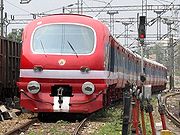
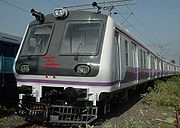
Special names
- Abhinav - Named to a WAP-4.
- Airavat - Named to some WDG-4'sEMD GT46MACThe EMD GT46MAC is a freight-hauling diesel-electric locomotive with AC electric transmission built by General Motors Electro-Motive Divisionin 1997–1998 for Indian Railways, where they are classed as WDG-4....
which belong to Gooty Diesel locomotive shed. - Baaz - (Bird of preyBird of preyBirds of prey are birds that hunt for food primarily on the wing, using their keen senses, especially vision. They are defined as birds that primarily hunt vertebrates, including other birds. Their talons and beaks tend to be relatively large, powerful and adapted for tearing and/or piercing flesh....
in HindiHindiStandard Hindi, or more precisely Modern Standard Hindi, also known as Manak Hindi , High Hindi, Nagari Hindi, and Literary Hindi, is a standardized and sanskritized register of the Hindustani language derived from the Khariboli dialect of Delhi...
) Mainly two WDP 4's 20011 & 20012 are called BAAZ, WDP-4's 20000-20009 also have the name stencilled on them in the side. - Baba Saheb - Named to a WAP-1 which is named after Babasaheb Ambedkar.
- Vallabh-Named to first WCAM-1 #21800.
- Balwant - Named to first WCAM-2 #21861.
- Cheetah - Named to some WDM-3D's.
- Dr.Silver - Named to a WAG-9, Its livery is Red unlike the standard green livery.
- Gajraj - Named to some diesel locomotives of 141xx series.
- Gajodhar
- Garuda - Named to first Microprocessor controlled WDG-2a.
- Jagjivan Ram - Named WAM-1 which is named after India's ex-Railway Minister Babu Jagjivan Ram
- Jawahar - Named to a WAP-1 which is named after India's first prime minister Jawahar Lal Nehru.
- Krishnaveni - Named to a WAG-5.
- Navodit - Named to first natively produced 3-phase Electric Passenger locomotive WAP-5.
- Nav Jagran - Named to a WAP-5.
- Nav Shakti - Named to a WAG-9.
- Nav yug - (New era in HindiHindiStandard Hindi, or more precisely Modern Standard Hindi, also known as Manak Hindi , High Hindi, Nagari Hindi, and Literary Hindi, is a standardized and sanskritized register of the Hindustani language derived from the Khariboli dialect of Delhi...
) Named to first natively produced 3-phase Electric Goods locomotive: WAG-9. - Prabal - Named to WDM-3A's which belongs to Lucknow Shed.
- Panther -Named to WAP-4e which belongs to Vadodara Shed
- Prayas - Named to a WAG-7.
- Rajhans - Named to a WAP-4e.
- Samrat - Named to a WAG-7.
- Shakthi - (Power in HindiHindiStandard Hindi, or more precisely Modern Standard Hindi, also known as Manak Hindi , High Hindi, Nagari Hindi, and Literary Hindi, is a standardized and sanskritized register of the Hindustani language derived from the Khariboli dialect of Delhi...
) Named to Some Micro-processor controlledMicrocontrollerA microcontroller is a small computer on a single integrated circuit containing a processor core, memory, and programmable input/output peripherals. Program memory in the form of NOR flash or OTP ROM is also often included on chip, as well as a typically small amount of RAM...
WDG-3A locomotives. - Shantidan - Named to first WAG-7 #27001 (March 29, 1992) (christened by Mother Teresa)
- Sukh Sagar Naveen - Named to a WAM-4.(Not in Service).
- Tiger Face - Refers to those WAG-7 locomotives which have red and white stripes on their front and painted red,white,blue,as opposed to being fully painted light blue.
See also
- Rail transport in IndiaRail transport in IndiaRail transport is a commonly used mode of long-distance transportation in India. Almost all rail operations in India are handled by a state-owned organisation, Indian Railways, Ministry of Railways. The rail network traverses the length and breadth of the country, covering a total length of...
- Indian RailwaysIndian RailwaysIndian Railways , abbreviated as IR , is a departmental undertaking of Government of India, which owns and operates most of India's rail transport. It is overseen by the Ministry of Railways of the Government of India....
- List of locomotive builders

